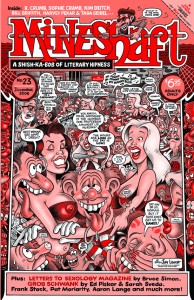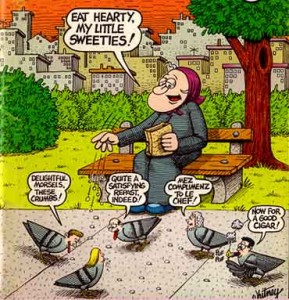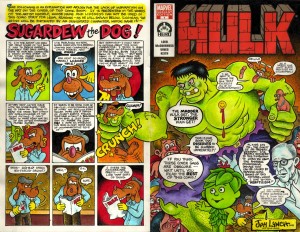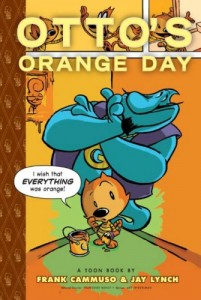When it comes to legends and people who have seen many changes in the comic industry one person comes to mind, Jay Lynch. He has been a part of the Underground Comix scene, worked for MAD Magazine, created Garbage Pail Kids art work, and written children’s books, to name just a few things in his industrious career. I asked Jay if I could feature him on my blog and to my delight he said “yes”. So I’m thrilled to share the conversation we had here with you now.
David: Hello Jay and thank you so much for taking the time to be featured on the “Don’t Pick the Flowers” blog. You have a great history in the comics world and were involved with the “Underground comix scene, what was it like to be apart of that revolutionary time especially compared with the current overflow of web comics today
Well…In 1960 I was in high school doing cartoons for the school paper and stuff. In an issue of Cracked magazine, which was edited by Paul Laikin back then, I saw a plug in the letter column that Paul gave to a kid in Pearl River, NY named Joe Pilati. Pilati had just published the first issue of SMUDGE, a little fanzine printed on a ditto machine that ran interviews and news about the guys who did the professional satire mags of the day…HELP!, MAD, CRACKED, SICK, those mags. So I sent for a copy, and wound up doing illustrations and cartoons for SMUDGE. That plug in Cracked was also seen by Skip Williamson, Art Spiegelman, and several other kid cartoonists. They all sent for SMUDGE and did drawings for SMUDGE. In the back of SMUDGE, Pilati would run reviews of amateur satire fanzines printed on ditto machines and mimeograph machines by kids around the country. Many of ’em contained original satirical articles on a variety of topics. Kids doing their own imitations of MAD.
The Crumb Brothers, Robert and Charles did one of these mags in l958 called FOO. Don Dohler, creator of Pro Junior, was doing one called WILD. Skip, Art and I then started doing stuff for WILD. This went on for a few years. Then we went to college and worked on the college humor mags. All the college humor mag guys were in touch with each other, and thru the college humor mags I met Shelton and Jaxon and Joel Beck and others who ultimately became underground cartoonists. Eventually the underground papers came along and we did stuff for them. Then Crumb sent me and Shelton copies of the first ZAP, and me and Skip in Chicago and Gilbert Shelton in Austin, Texas decided to do comix like ZAP too. And that’s how it started. But it had been going on for 7 or 8 years prior to that. We had fun with the fanzines…and I started traveling around a lot during the days of the college humor mags. Underground comix were an extension of that, and of what Kurtzman had been doing years before we got into it. In HELP! magazine, Kurtzman printed the work of most of the early underground comix guys years before there were underground comix.
David: You are well known for “Nard n’ Pat” and the comic strip “Phoebe and the Pigeon People” how did these stories and characters come about?
I was working in an advertising art agency in ’67. And they’d let us do our own work there if we didn’t have an assignment to do for the company. They wanted us to always be busy, in case a client should drop by. So the first Nard n’ Pat strips that ran in THE CHICAGO SEED newspaper, I did at work. I had two friends named Nard and Pat. One was an ultra conservative and the other was a radical liberal…and it was always interesting to me when these two got together and they would argue, and neither would listen to what the other was saying. So I thought that would be a good premise for a strip. Phoebe began in the late ’70s. By this time one of the SEED editors was editing a youth section for the CHICAGO DAILY NEWS called SIDETRACKS. He asked for a strip, so I did roughs of a dozen or so Phoebe strips. I never heard back from him. A year or so later, SIDETRACKS ceased publication, and he was cleaning out his desk and found the roughs and sent ’em back to me. I sent them to THE CHICAGO READER, and they said they’d love to have the strip. I didn’t really feel like drawing the same characters every week, though. Then I saw Gary Whitney’s business card tacked to the bulletin board of a head shop called ON THE BUS. So I called Gary, whom I hadn’t met before that, and asked if he wanted to team up. He draws. I write. He said he did. And Phoebe lasted for something like 17 years. I guess the reason I did Phoebe is that it is about birds. Nard n’ Pat was about a cat. A cat is a Jungian archetype associated with sex. A bird is a Jungian archetype associated with death. So it gave me that whole area to do gags in.
David: Wacky Packages and Garbage Pail Kids is part of your work/portfolio, and well remembered. I can remember some people being disturbed by them, what’s your thoughts on them now and where did the ideas for them come from?
Both series were conceived mainly by Art Spiegelman. MAD had stopped parodying ads and products then, since they’d get cease and desist letters from the trademark owners giving them 90 days to take the mag off the stands. This was in l967, before SATURDAY NIGHT LIVE and the modern American satire industry became what it is today. At first it didn’t matter to MAD, since the mag wasn’t going to be on the stands for 90 days anyway. But then MAD started doing all these reprint books, so they stopped parodying products so much, because the parodies couldn’t be reprinted if they got a cease and desist letter and agreed to cease and desist. Topps had no intention to reprint WACKY PACKS then, and the gum they came with had a shelf life of under 90 days. So Topps picked up the gauntlet. Garbage Pail Kids started in the ’80s. Spiegelman developed the method of a character with an adjective describing a proper name. Messy Tessie….Jay Decay…Undead Fred…. Everyone thought the idea to just parody one thing was crazy. Only the owner of the company wanted to do it. But Art made it work. I wrote a lot of the gags. Jokes about all of the bodily fluids. Hopefully they’ll discover more bodily fluids. I’m starting to run out. I don’t think we did smegma yet, though.
 David: Mad Magazine is another part of your portfolio. Everyone has probably owned at least one copy and is an American institution. What was it like to work for Mad?
David: Mad Magazine is another part of your portfolio. Everyone has probably owned at least one copy and is an American institution. What was it like to work for Mad?
The best incarnation of MAD was the early issues. The ones that Harvey Kurtzman edited. The ten-cent comic version of MAD and the first few issues of the 25 cent magazine version of MAD were pure genius. Kurtzman split in a pay dispute in 1956. Al Feldstein took over as editor after that, and under Feldstein the mag started to make money. And I gotta respect Feldstein’s ability to make a mag that appealed to the masses. But I liked Kurtzman’s MAD much better. So I would work for Kurtzman’s mag HELP! But I think most of us who learned everything we know from studying Kurtzman’s methods never had any real desire to work for the post-Kurtzman MAD. And Kurtzman and Gaines were more or less adversaries for decades. But some time around the late ’80s they buried the hatchet, and Kurtzman and Elder started doing stuff for MAD again. So I thought it would appropriate for me to do MAD stuff too. It was fun. It’s hard to write for MAD, in that the mag is prepared many months in advance, so you gotta be sure the topic you write on will still be on the public’s mind when the mag finally comes out. This gets more and more difficult as the media becomes more hyper. A movie or book can come out, make millions, and disappear totally in 3 weeks these days. So I guess the hardest part of doing MAD stuff is to choose a topic that won’t be forgotten by the time the mag hits the stands. Now that MAD is quarterly…this problem is greater than ever, I think.
David: More recently you have illustrated children’s books, “Otto’s Orange Day” and “Mo and Jo”. How hard was it to make a transition from your past work to illustrating these books?
I wrote those books. I didn’t illustrate ’em. OTTO’s ORANGE DAY is illustrated by Frank Cammuso, the political cartoonist for the Syracuse newspaper. MO AND JO FIGHTING TOGETHER FOREVER is illustrated by Dean Haspiel…who does lots of comic book work. Actually, I wrote dozens of kid’s sticker activity albums and gumcard series and all kinds of kids stuff over the years. I did illustrate a DUCKMAN comic for Topps once. Mainly I write stuff, and do color roughs and other people draw it or paint it.
David: One last question, what advice do you give to anyone who wants to be involved with creating comics/cartoons?
I would say that if they have a unique vision, the thing to do is to publish it yourself. Either through traditional print media or on the web, then people will come to you. You can send stuff to publishers, but the only stuff they are likely to publish is stuff that looks like something that was previously published and was successful. So you gotta create your own market….or you can draw Marvel characters and try to get a gig doing that. But I think publishing one’s own stuff is more heroic….and is probably the only way to do cartoons without regret. I mean, maybe you won’t make any dough at all…but at least you will save lots of money on psychiatrist bills and substance abuse rehab clinics.
Thank you Jay for being featured and sharing some insight into your world. It’s amazing to see your work, hear about the people you’ve worked with, and learn about your history in the comics world. Thank you for the privilege of sharing that here.





